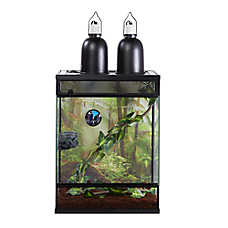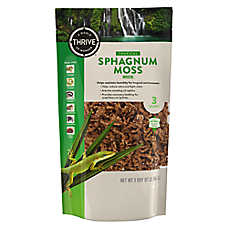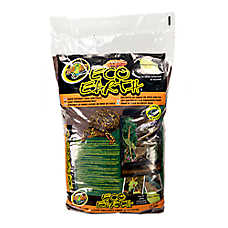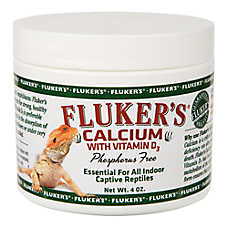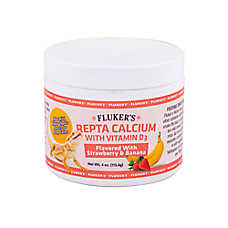Green Tree Frog Digital Care Guide
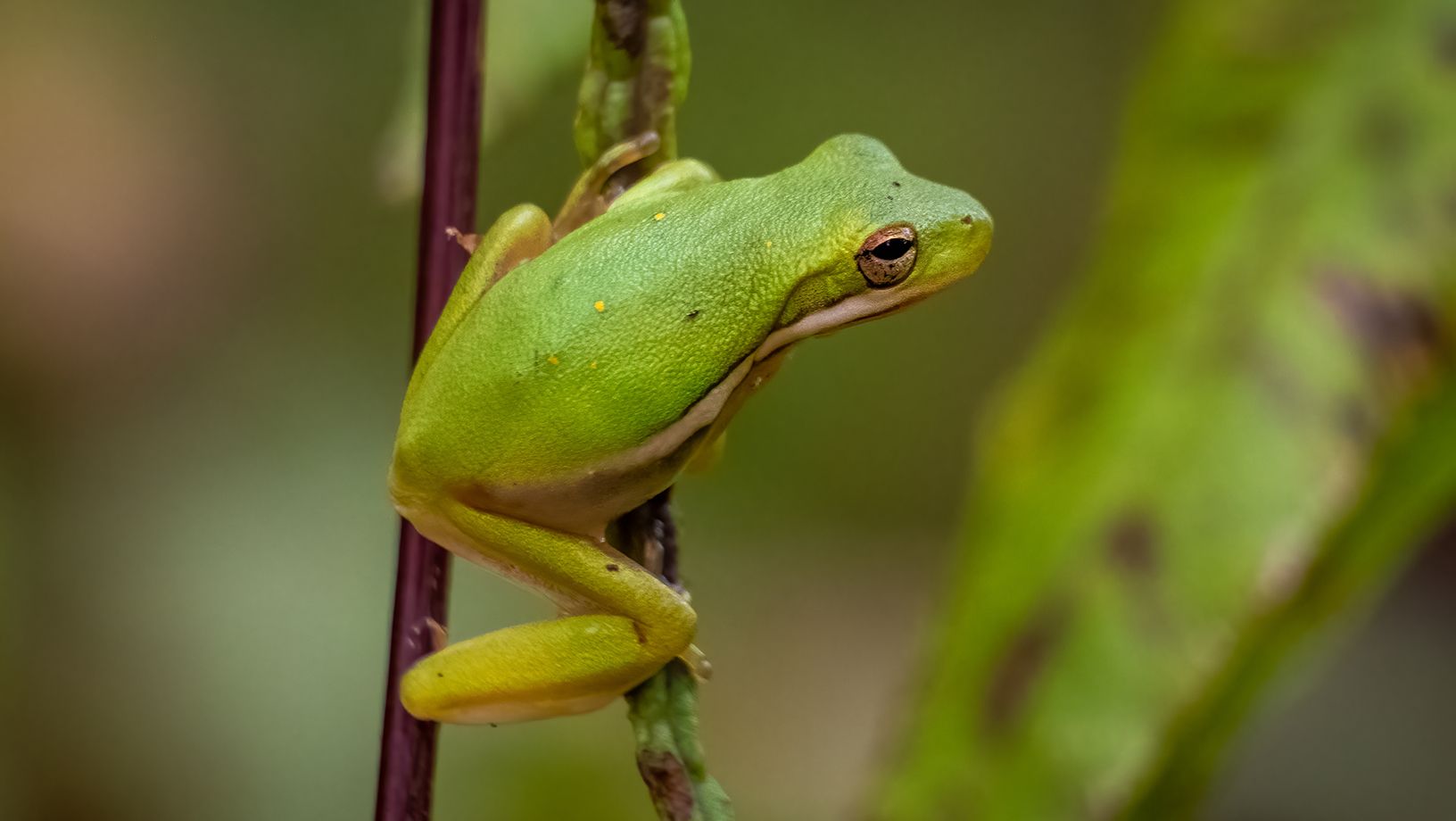
In this Article
Gorgeous green tree frogs
Green tree frogs are a species of tree frog that are native across the central and southeastern United States. They are nocturnal, meaning they are most active during the evening and night. These frogs are interesting in that they spend their time in the tree canopy, but they always establish a territory that includes a permanent water source, like a pond or stream. This is because during mating and hibernation seasons, the green tree frog will spend significantly more time in the water! They are primarily green, but that can range from a brighter lime-green to dark forest-green, and they typically have a white stripe on their sides.
Green tree frog species profile:
Size: Green tree frogs can grow up to 2.5" (6cm).
Lifespan: On average they live 5-6 years, but with excellent care some animals live 15-20 years!
Habitat: Green tree frogs are arboreal-tropical animals. This means they spend their days in trees and enjoy a humid environment.
Behavior: These frogs spend most of their time in the trees, but do come down from time to time.
Temperament: Best as display animals, but may tolerate occasional handling with proper care.
Social housing: Can be kept alone or in small groups of two to three females. Males may be housed with females but may attempt to breed.
Note: Because Green tree frogs have porous skin, if you plan to handle your frog, it is recommended you wash your hands prior to handling or wear gloves in order to prevent your frog from absorbing any of the lotion or anything else that might be on your skin that could make your frog very sick
Setting up your green tree frog habitat
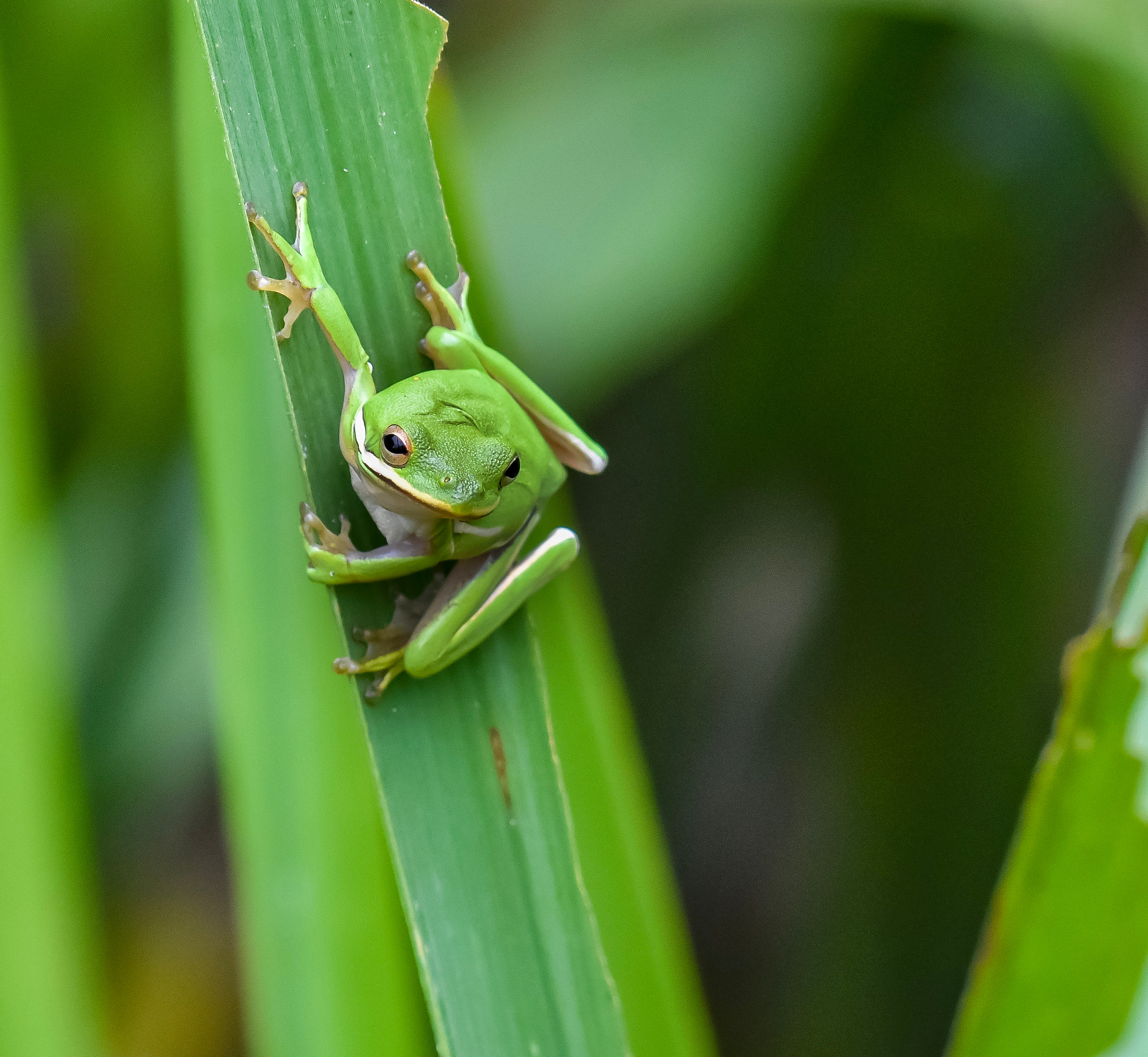
Green tree frogs thrive in tall, humid enclosures with plenty of vertical space and dense foliage. A properly set up habitat helps reduce stress, support hydration, and promote natural behaviors like climbing and nocturnal exploration.
Enclosure size and setup
- For one to three frogs, use a vertically oriented terrarium that is at least 24 inches tall and 20 gallons in volume
- The enclosure should have a secure screen lid, which is essential for ventilation and to prevent escapes
- Line the bottom with reptile carpet or a 2–3 inch mix of sphagnum moss and coconut fiber, peat moss, or reptile-safe soil
- Avoid loose substrates like gravel or sand that can cause impaction if swallowed
- Set up your lighting outside the terrarium, over top the screened lid, so your frog has a warm area to bask in but cannot get so close to the bulb that they are burned.
- Many reptiles and amphibians benefit from having access to UVB lighting. UVB allows the body to synthesize vitamin D3 which is critical for absorption of calcium. Some daylight bulbs will be rated to also provide UVB, and some won’t so it is important to check. Providing low-intensity UVB light over the basking site is recommended.
- Frogs need a 12- hours light cycle to regulate their sleep cycle. Using a timer on your lighting makes this easy to accomplish
- Spot clean daily, stir or cycle bedding every other week, and replace entirely once a month to maintain hygiene.
Climbing structures and environmental décor
- Add stable vertical and horizontal branches, vines, and real or artificial plants to create a dense climbing area
- Include plenty of elevated hiding spots to help your frog feel secure
- Make sure all climbing elements are firmly anchored and easy for your frog to grip
Tree frogs are most active at night and prefer shaded, cluttered spaces during the day. Mimic their natural environment by filling the upper third of the enclosure with foliage and perches.
Temperature and humidity
Green tree frogs require a warm and humid tropical environment, maintained through a temperature gradient (a warm end and a cooler end in their habitat) and regular misting. Use a low-wattage heat bulb or a ceramic heat emitter to provide warmth to the upper-end of habitat to create this temperature gradient. As long as the overnight temperature does not go under 70F, you may turn off heating element at nigh
Ideal ranges:
Zone | Temperature |
Basking area (top) | 80–85°F (27–29°C) |
Daytime ambient (lower) | 75–80°F (24–27°C) |
Night | 70–75°F (21–24°C) |
Humidity | 60–80% |
What to feed your green tree frog
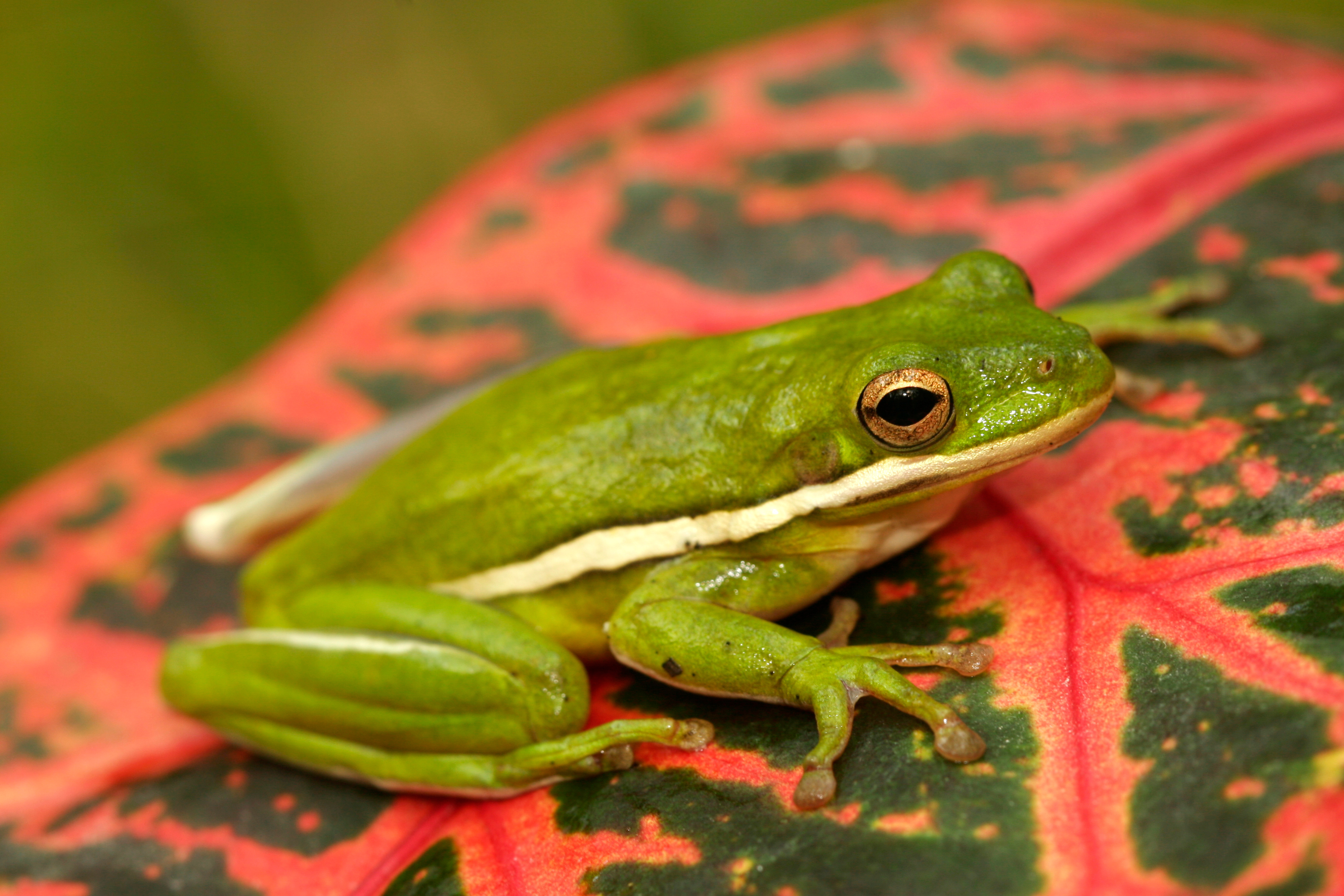
Green tree frogs are insectivores that thrive on a diet of gut-loaded live insects. Feeding should reflect their nocturnal habits, with food offered in the early evening to align with natural activity patterns.
Insect diet
- Juveniles (under 1 year): Feed daily in the evening
- Adults: Feed every other day
Offer a mix of appropriately sized gut-loaded insects to provide variety and ensure balanced nutrition:
- Crickets
- Dubia roaches
- Mealworms (occasionally)
Use feeding tongs if needed, and always remove uneaten insects after a few hours to avoid stress or injury to your pet.
Supplementation
- Calcium with vitamin D3: Dust insects twice weekly
- Reptile multivitamin powder:
- Juveniles: Once per week
- Adults: Twice per month
These supplements help prevent common deficiencies and support bone health, especially in frogs that don’t receive UVB lighting.
What does “gut-loaded” mean?
Gut loading refers to feeding live insects a nutritious diet before offering them to your frog. This increases the nutrient content of the prey and improves your frog’s overall health. Most commercially available insects are gut loaded, but you can also do this at home using high-quality insect feed.
Gut loading refers to feeding live insects a nutritious diet before offering them to your frog. This increases the nutrient content of the prey and improves your frog’s overall health. Most commercially available insects are gut loaded, but you can also do this at home using high-quality insect feed.
Water access
- Provide a large, shallow dish of dechlorinated water at all times for soaking and drinking
- Replace the water daily, and clean the dish thoroughly to prevent bacterial growth
Chlorine and chloramines in tap water can harm amphibians, so always use a reptile-safe water conditioner or let tap water sit uncovered for 24–48 hours before use.
Important:
Never feed your frog wild-caught insects. They may carry parasites or have been exposed to pesticides, which can make your frog very sick.
Never feed your frog wild-caught insects. They may carry parasites or have been exposed to pesticides, which can make your frog very sick.
When to see a vet
In addition to regularly scheduled appointments, contact your amphibian veterinarian if you notice the following signs:
- hiding more than usual
- eating or drinking less; weight loss
- swollen joints or reluctance to move
- discharge from the eyes, nose or mouth
- discolored skin
- runny or decreased droppings
- inability to open/close mouth
Go to “find a vet” on arav.org for help finding an amphibian veterinarian in your area
NOTE: Most, if not all, reptiles carry Salmonella bacteria in their intestinal tract and intermittently or continuously shed these bacteria in their feces, so they are unsuitable pets for very young children and those with compromised immune systems. Good hygiene must always be practiced around all reptiles, and hands should be washed before and after interacting with reptiles.
SHOPPING CHECKLIST
- screened or glass terrarium 24" tall
- reptile carpet, mat, or soil combination (coconut fiber or peat moss), reptile bark and/or sphagnum moss
- UVB fluorescent bulb and fixture
- ceramic heat emitter and fixture
- habitat thermometer(s) and hygrometer
- branches, plants and/or cork bark for climbing and hiding
- spray bottle or an automatic fogger/mister
- food bowl and water bowl
- crickets, dubia roaches, hornworms and mealworms
- calcium powder
- multivitamin powder
Ready to learn more? This guide is a great starting place, but we encourage you to do more research on the individual species that you are keeping so that you can be as successful as possible!
Related guides:
SKU Selection: 5315225- Thrive Tropical Reptile Terrarium Essentials Kit 5291031- Thrive Sphagnum moss 5210906- ZOO MED 24QT ECO EARTH LOOSE SOIL 5290803- THRIVE LOOSE COCONUT SOIL 24 QT 5353958- Thrive Tri Log Hide 5047843- FLUKERS REPTA-CALCIUM SUPPLMNT:4 OZ 5284946-STAWBERRY BANANA CALCIUM W/D3
FAQs
Can green tree frogs live together?
Yes, but only in small, same-species groups. It’s safest to house two to three female green tree frogs together. Males are territorial and should not be housed with other males. One male may be kept with one or two females, but this may lead to unwanted breeding.
Yes, but only in small, same-species groups. It’s safest to house two to three female green tree frogs together. Males are territorial and should not be housed with other males. One male may be kept with one or two females, but this may lead to unwanted breeding.
How often should I feed my green tree frog?
Juvenile frogs should be fed every evening, while adult frogs typically eat every other evening. Offer a variety of live, gut-loaded insects such as crickets or roaches. Always remove uneaten food after a few hours.
Juvenile frogs should be fed every evening, while adult frogs typically eat every other evening. Offer a variety of live, gut-loaded insects such as crickets or roaches. Always remove uneaten food after a few hours.
Do green tree frogs need UVB lighting?
UVB is not required for survival, but it can benefit their long-term health. Providing low-intensity UVB light supports natural vitamin D3 synthesis, which helps your frog absorb calcium and prevent metabolic bone disease.
UVB is not required for survival, but it can benefit their long-term health. Providing low-intensity UVB light supports natural vitamin D3 synthesis, which helps your frog absorb calcium and prevent metabolic bone disease.
Can I handle my green tree frog?
Green tree frogs have sensitive, porous skin and should be handled as little as possible. If you do handle your frog, wash your hands first or wear clean, powder-free gloves. Limit handling to brief sessions and avoid handling after using lotions or hand sanitizer.
Green tree frogs have sensitive, porous skin and should be handled as little as possible. If you do handle your frog, wash your hands first or wear clean, powder-free gloves. Limit handling to brief sessions and avoid handling after using lotions or hand sanitizer.
How can I tell if my frog is sick?
Watch for signs like lethargy, poor appetite, weight loss, discolored skin, shedding problems, or changes in basking behavior. If you notice anything unusual, consult an exotic animal veterinarian. You can find one near you at arav.org.
Watch for signs like lethargy, poor appetite, weight loss, discolored skin, shedding problems, or changes in basking behavior. If you notice anything unusual, consult an exotic animal veterinarian. You can find one near you at arav.org.
